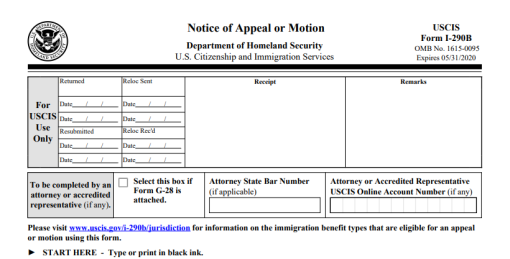Form I-290B, known as the Notice of Appeal or Motion serves as a formal means for individuals to challenge or seek a review of decisions made by the U.S. Citizenship and Immigration Services (USCIS) or the Administrative Appeals Office (AAO). There are three primary scenarios in which Form I-290B may be utilized:
- Appeal with the Administrative Appeals Office (AAO): If an individual disagrees with a decision made by USCIS and wishes to challenge it, they can file an appeal with the AAO using Form I-290B. The AAO is an independent entity that reviews and considers appeals on immigration-related matters.
- Motion with the USCIS Office: In cases where the USCIS office issued the most recent decision, including field offices, service centers, or the AAO, individuals can file a motion using Form I-290B. A motion is a request for the USCIS office to reconsider or review its decision, typically based on new evidence or legal arguments.
- Certain Appeals Related to ICE Form I-17: Form I-290B is also applicable in specific situations where an individual faces the denial of an Immigration and Customs Enforcement (ICE) Form I-17, which is the Petition for Approval of School for Attendance by Nonimmigrant Student. This pertains to appeals within the ICE Student and Exchange Visitor Program.

Completing Form I-290B requires attention to detail, as it must clearly outline the reasons for the appeal or motion and provide supporting documentation. The form is a formal way for individuals to seek a review of their immigration case and is typically used after receiving a denial or unfavorable decision from USCIS. Seeking legal advice or assistance may be beneficial for individuals navigating this process to ensure accuracy and improve the chances of a successful appeal or motion.
I-290B Appeal vs Motion
- Appeal: An appeal goes to a different authority, usually the Administrative Appeals Office (AAO) within USCIS. They haven’t seen your case before and will make a fresh decision based on the submitted arguments and evidence.
- Motion: A motion is filed with the same office that made the original decision. They’ll reconsider your case based on the new information or arguments you present.
Cost of Filing I-290B
In general, it costs $675 to file I-290B.
Payment options include a money order, personal check, cashier’s check, or pay by credit card using Form G-1450, Authorization for Credit Card Transactions. If you pay by check, you must make your check payable to the U.S. Department of Homeland Security.
If you are a special immigrant Iraqi or Afghan national who worked for or on behalf of the U.S. government, you do not need to pay a fee when you file Form I-290B to appeal a denial of a petition for a special immigrant visa.
How Long Does An I-290B Appeal Take?
Following the submission of the application, the processing center responsible for the initial case review aims to complete its assessment within 45 days. In the case of appeals where the original decision is upheld, the Administrative Appeals Office (AAO) endeavors to render a decision within 180 days from the date of receiving the appeal. For motions to reconsider and/or reopen, the target timeframe for a decision is 90 days.
It’s important to recognize that these timeframes serve as general targets set by USCIS. In practice, the processing of appeals may extend up to a year or even longer in certain situations.
When to File I-290B?
Typically, it is necessary to submit your appeal or motion within 30 calendar days from the date of receiving the unfavorable decision (or within 33 calendar days if the decision was mailed to you by us). However, in the case of appealing a decision to revoke the approval of an immigrant petition under 8 CFR 205.2, the filing deadline is shortened to 15 calendar days (or 18 calendar days if the decision was mailed to you). It is essential to adhere to these specific timelines to ensure the timely processing of your appeal or motion.
What happens if I-290B is approved?
If your Form I-290B, Notice of Appeal or Motion, is approved, it means that the decision on your original immigration application or petition has been reconsidered, and a favorable outcome has been reached. The approval of an I-290B indicates that the authorities have reviewed the additional information, arguments, or evidence you provided and have found it compelling enough to reverse the initial adverse decision.
The specific consequences of an approved I-290B depend on the nature of the original application or petition. For example:
- Visa or Immigration Benefit Applications: If your I-290B relates to a visa or immigration benefit application that was initially denied, an approval means that your application is now accepted, and you may proceed with the next steps in the immigration process. This could involve the issuance of a visa, adjustment of status, or any other relevant immigration benefit.
- Immigrant Petitions: In the case of an immigrant petition, approval means that the petition is now considered valid, and the associated benefits, such as obtaining a green card, can move forward.
- Other Immigration Matters: The impact of an approved I-290B can vary based on the specific context of your case. It is essential to carefully review the details provided in the approval notice to understand the next steps and any implications for your immigration status.
Keep in mind that the approval of the I-290B does not necessarily guarantee immediate action. Depending on the nature of the approval, additional processing steps or actions may be required, so it’s advisable to thoroughly read any accompanying documentation and follow any instructions provided by the U.S. Citizenship and Immigration Services (USCIS) or relevant authorities. If you have any concerns or questions, seeking guidance from an immigration attorney can be beneficial to ensure a smooth transition in your immigration process.
What happens if I-290B is denied?
If your I-290B is denied, it doesn’t necessarily mean the end of the road for your immigration case. Here are your options:
1. No further action: You can accept the USCIS decision and potentially explore alternative immigration pathways if applicable.
2. Federal Court Appeal: If your case meets specific criteria, you can file a lawsuit in federal district court challenging the USCIS decision. This option typically requires legal representation due to its complexities.
4. Exploring alternative forms of relief: Depending on your circumstances, you might be eligible for other forms of immigration relief, such as humanitarian programs or visa options not considered in your original application. Consult with an immigration attorney to explore all possibilities.
It’s important to note that the specific options available to you will depend on the type of application you filed, the reason for the denial, and your individual circumstances. Consulting with an immigration attorney is highly recommended to understand your options and determine the best course of action after an I-290B denial.
For more information on Immigration Law, an initial consultation is your next best step. Get the information and legal answers you are seeking by calling 904-999-4928 today.







